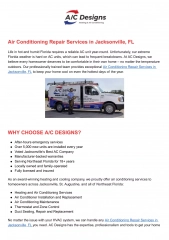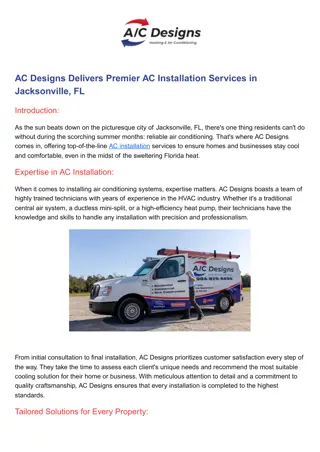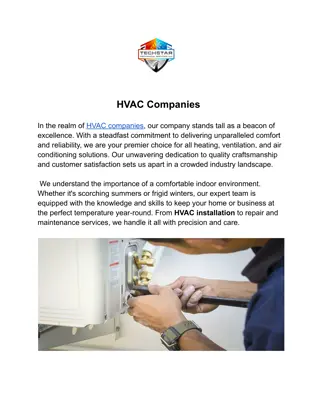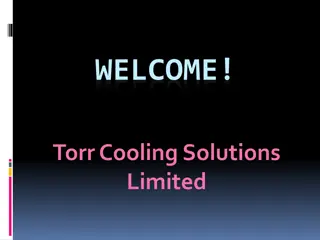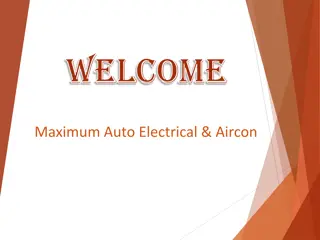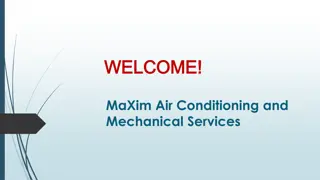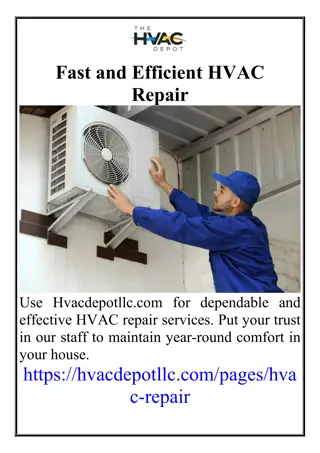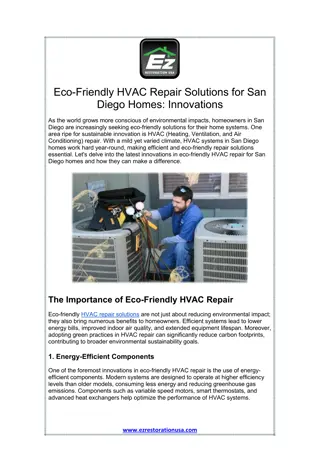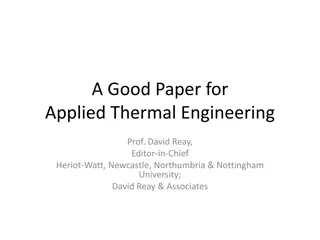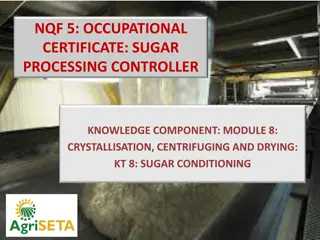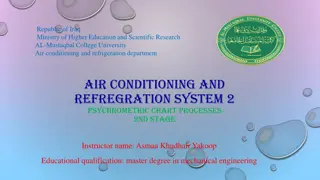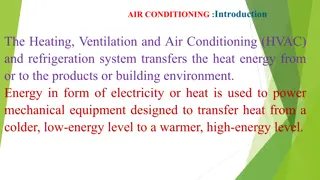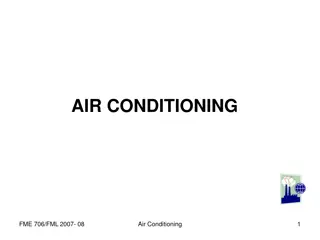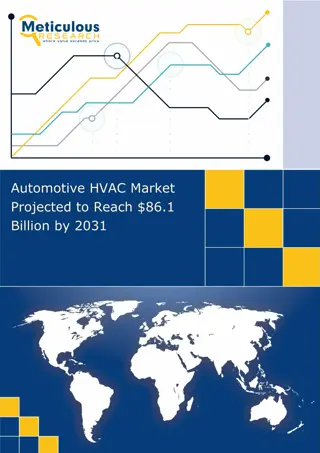Introduction to Environmental Thermal Engineering: Air Conditioning Systems and HVAC Applications
This lecture covers the fundamentals of air conditioning systems, including the equipment, HVAC systems, and applications. It explains the concept of air conditioning, its processes, and its significance in controlling temperature, humidity, cleanliness, and air distribution for occupant comfort. Additionally, it delves into the relationship between refrigeration and air conditioning fields, highlighting the importance of HVAC in heating, ventilating, air conditioning, and refrigeration. The presentation also discusses traditional heating systems and the principles of heating, emphasizing energy transfer methods and the role of ventilation in maintaining indoor air quality by addressing common contaminants like gases, volatile organic compounds, and particulate matter.
- Environmental Engineering
- Thermal Engineering
- Air Conditioning Systems
- HVAC Applications
- Indoor Air Quality
Download Presentation

Please find below an Image/Link to download the presentation.
The content on the website is provided AS IS for your information and personal use only. It may not be sold, licensed, or shared on other websites without obtaining consent from the author. Download presentation by click this link. If you encounter any issues during the download, it is possible that the publisher has removed the file from their server.
E N D
Presentation Transcript
Environmental Thermal Engineering Lecture # 11 Min soo Kim Mechanical & Aerospace Engineering
Contents 1. Introduction 2. Equipments of Air Conditioning Systems 3. HVAC Systems 4. HVAC Applications
What is air-conditioning? The process of treating air to control simultaneously its temperature, humidity, cleanliness and distribution to meet the comfort requirements of the occupants of the conditioned space ( ASHRAE Handbook, Fundamentals, American Society of Heating, Refrigerating and Air-Conditioning Engineers)
Air-conditioning Relationship of the refrigeration and air-conditioning fields Air Conditioning Refrigeration Industrial Refrigeration, Including food Preservation, Chemical, and process industries Cooling and Heating, Humidifying and Control of Air Quality Dehumidifying Operations in Air- Conditioning
HVAC & R Heating Ventilating Air Conditioning Refrigeration
Heating A4frkst Traditional Heating Systems Hearth, Franklin Stove, etc Franklin Stove : Burning wood above a cold air duct heats air which then passes through baffles and is released through vents on each side of the stove Ondol (Korean) : floor radiant heating system
Heating Heating is the transfer of energy from a source to a space by following processes; - direct radiation - free convection Rate of sensible heating of air; Qc v p = = ( ) ( ) q mc T T T T s p e i e i 3 : volume flow rate of air flow [m /s] Q : rate of sensible heat transfer [W] s q 3 : specific volume of air [m /kg] v : mass rate of air flow [kg/s] m : temperature of air at exit [K] e T : const-pressure specific heat of air [J/kgK] p c : temperature of air at inlet [K] i T
Ventilation Common contaminants Gases : carbon dioxide(CO2), carbon monoxide(CO), SO2, NO2 Volatile Organic Compounds (VOCs) Particulate Matter : soot, smoke, clay and bacteria, etc Basic Methods to maintain good IAQ(indoor air quality) Source elimination or modification Use of outdoor air Space air distribution Air cleaning
Ventilation A typical ventilation system Exhaust (relief air) Return air Conditioned Space Recirculated air Heating Coil Cooling Coil Make-up outdoor air Fan Filter Supply air
Air Conditioning W.H. Carrier Established Psychrometric Formulae (1911) Centrifugal Chiller (1921) -first practical method of air conditioning for large spaces Willis H. Carrier (1876~1950) TIME King of Cool 100 builders & titans of 20thcentury Carrier s Centrifugal Chiller (1921)
Primary Equipments of HVAC Air-Handling Equipment Heating Equipment Refrigeration Equipment Other Energy Saving Equipments - Thermal storage - Energy recovery - Solar energy - Geothermal
Air Handling Equipment Duct Construction Air-Diffusing Equipment Fans Evaporative Air Cooling Equipment Humidifiers Air-Cooling and Dehumidifying Coils Desiccant Dehumidification
Duct Construction Duct system delivers a specific amount of air to each diffuser in the conditioned space at a specified total pressure. Duct construction is classified by application and pressure ; 125 Pa, 250 Pa 125 Pa ~ 2500 Pa Residences Commercial Systems Industrial Systems Any pressure
Duct Construction Pressure Drop in Duct p: Pressure drop [Pa] f: friction factor L: Length [m] D: Inner diameter of duct [m] Deq: Equivalent diameter [m] V: velocity [m/s] : density [kg/m3] 2 L V D = p f 2 2 L V = p fD 2 eq 4 area = D eq perimeter
Duct Construction Pressure Drop in Fittings Sudden Enlargement 2 2 V A A = 1 1 1 loss P 1 2 2 2 Sudden Contraction A A V V = = 1' 2 C C 2 1' 1 1 2 2 2 2 2 1 V A A V = = 1 1 1' 1' 2 loss P 2 2 C 2 C
Duct Construction Pressure Drop in Fittings Turns (90 ) 2 V = 2 (geometry factor) loss P 2 Ratio Geometry factor = radius of curvature/diameter Mitered 0.5 0.73 1.0 1.5 2.0 1.30 0.90 0.45 0.33 0.24 0.19
Duct Construction-cleaning Ducts should be designed, constructed, and maintained to minimize the opportunity for growth and dissemination of microorganisms. Cleaning
Air Diffusing Equipment Requirements of air distribution; The flow rate must compensate for the net heat loss or gain in the space The velocity must not be higher than 0.25 m/s in the occupied regions of the room There should be some motion of air to breakup temperature gradients in the room (warm air at the ceiling and cold air at the floors)
Air Diffusing Equipment Types of Supply Air Outlets Grille and Register Outlets Linear Louver diffuser Linear Slot Outlets Ceiling Diffuser Outlets Linear Slot diffuser Ceiling Diffuser Outlets Perforated diffuser
Fans Fan is an air pump that creates a pressure difference and causes airflow. Types of Fans Centrifugal Fan Axial Fan
Centrifugal fans Centrifugal Fans Air enters the fan - Turns and moves into the blades - Enters the scroll Produce pressure from; - Centrifugal force created by rotating the air - Kinetic energy imparted to the air
Centrifugal fans Centrifugal Fans Type Figure Characteristics Highest efficiency of all centrifugal fan designs. 10~16 blades of airfoil contour curved away from direction of rotation. Deep blades allow for efficient expansion within blade passages. Air leaves impeller at velocity less than tip speed. For given duty, has highest speed of centrifugal fan designs Airfoil Backward- inclined Backward- curved Efficiency only slightly less than airfoil fan. 10~16 single-thickness blades curved or inclined away from direction of rotation. Efficient for same reasons as airfoil fan.
Centrifugal fans Type Figure Characteristics Higher pressure characteristics than airfoil, backward- curved (inclined) fans. Curve may have a break to left or peak pressure and fan should not be operated in this area. Power rises continually to free delivery. Radial Flatter pressure curve and lower efficiency than the airfoil, backward-curved (inclined) fans. Do not rate fan in the pressure curve dip to the left of peak pressure. Power rises continually toward free delivery. Motor selection must take this into account Forward- curved
Centrifugal fans Centrifugal Fans Performance Curves Type Performance curves Performance characteristics Highest efficiencies occur at 50 to 60% of wide open volume. This volume also has good pressure characteristics. Power reaches maximum efficiency and becomes lower, or self- limiting, toward free delivery. Airfoil near peak Backward-inclined Backward-curved Similar to air foil fan, except peak efficiency slightly lower.
Centrifugal fans Centrifugal Fans Performance Curves Type Performance curves Performance characteristics Higher airfoil Pressure may drop suddenly at left of peak pressure, but this usually causes no problems. Power rises continually to free delivery. pressure and characteristics backward-curved than fans. Radial Pressure curve less steep than that of backward-curved fans. Curve dips to left of peak pressure. Highest efficiency to right of peak pressure at 40 to 50% of wide open volume. Rate fan to right of peak pressure. Account for power curve, which rises continually delivery, when selecting motor. Forward-curved toward free
Axial Fans Produce pressure from the change in velocity passing through the impeller
Axial Fans Axial Fans Type Figure Characteristics Low efficiency. Limited to low-pressure applications. Usually low cost impellers have two or more blades of single thickness attached to relatively small hub. Primary energy transfer by velocity pressure. Propeller Somewhat more efficient and capable of developing more useful static pressure than propeller fan. Usually has 4~8 blades with airfoil or single-thickness cross section. Hub is usually less than half the fan tip diameter. Tubeaxial
Axial Fans Good blade design gives medium-to high- pressure capability at good efficiency. Most efficient of these fans have airfoil blades. Blades may have fixed, adjustable, or controllable pitch. Hub is usually greater than half fan tip diameter. Vaneaxial
Axial Fans Axial Fans Performance Curves Type Performance curves Performance characteristics High flow rate, but very low-pressure capabilities. Maximum efficiency reached near free delivery. Discharge pattern circular and airstream swirls. Propeller High capabilities. Performance curve dips to left of peak pressure. Avoid operating fan in this region. Discharge pattern circular and airstream rotates or swirls. flow rate, medium-pressure Tubeaxial High-pressure medium-volume Performance curve dips to left of peak pressure due to aerodynamic stall. Avoid operating fan in this region. Guide vanes correct circular motion wheel and improve characteristics and efficiency of fan. characteristics flow with capabilities. Vaneaxial imparted by pressure
Psychrometric Chart Cooling, Humidification and Dehumidification
Evaporative Air Cooling Equipment An evaporative cooler produces effective cooling by combining a natural process - water evaporation - with a simple, reliable air-moving system. Fresh outside air is filtered through the saturated evaporative media, cooled by evaporation, and circulated by a blower wheel
Evaporative Air Cooling Equipment Advantages - Substantial energy & cost savings - Reduced peak power demand - Improved indoor air quality - Life cycle cost effectiveness - Easily integrated into built-up systems - Environmental benign
Humidifiers Residential Humidifiers Wetted-Drum Humidifier Pan Humidifier Power Wetted-Element Humidifier Atomizing Humidifier
Humidifiers Humidifiers Load calculation For ventilation systems having natural infiltration ( ) = VR W + H W S L i o For mechanical ventilation systems having a fixed quantity of outside air ( ) = Q W + H W S L o i o H = humidification load, kg/h V = volume of space to be humidified, m3 R = infiltration rate, air changes per hour Qo = volumetric flow rate of outside air, kg/h Wi = humidity ratio at indoor design conditions, kg(water)/kg(dry air) Wo = humidity ratio at outdoor design conditions, kg(water)/kg(dry air) S = contribution of internal moisture sources, kg/h L = other moisture losses, kg/h = density of air at sea level, 1.2kg/ m3
Air-Cooling and Dehumidifying Coils Fluid inside the coil - Water and Aqueous Glycol Coils - Direct-Expansion Coils (refrigerant inside) Coil design: Extended surface (finned) cooling coil - most popular and practical
Desiccant Dehumidification The use of chemical (or physical) absorption of water vapor to dehumidify air and reduce the latent cooling load in a building HVAC system Advantage Reduces cost of cooling Improves product quality for companies with moisture sensitive products Improves occupant comfort Increases overall cooling capacity of existing cooling equipment Reduces the amount of conventional cooling and elective demand Improves indoor quality by reducing airborne bacteria and fungus
Desiccant Dehumidification Traditional System Dehumidification was achieved by lowering the temperature of the air. Large energy required because air is over-cooled. DDwheel Rotary Dehumidification Unit Desiccant dehumidification flows air from the building over a porous material that attracts moisture. The porous material attracts moisture until it is saturated and can hold no more. Warm air is then passed over the desiccant and the moisture is released and exhausted to the outside
Desiccant Dehumidification 1: Process air "ON" 2: Filter 3: Rotor 4: Process air fan 5: Process air "OFF" (Dry air) 6: Regeneration air "ON" 7: Filter 8: Heating elements 9: Drive motor 10: Regeneration air fan 11: Regeneration air "OFF" (Wet air)
Heating Equipment Boiler Furnace Residential In-Space Heating Equipment
Boilers Basic Classification of Boilers: working pressure and temperature Medium & High- Pressure Boiler Low-Pressure Boiler Pressure : 100~200 kPa (Water) 1,100 kPa (Steam) Temperature : 120 C Steam Boilers / Water Boilers
Boilers - Other Classifications: Fuel Used: coal, fuel oil, gas / electricity Construction Material: cast-iron, steel, copper, stainless steel, etc Condensing/Non-condensing Boilers: Condensing fuel gas in the boiler Etc Boiler classifications are important to the engineers because they affect performance, first cost and space requirements.
Boilers Condensing Boilers Hot exhaust gases condense and lose much of their energy to pre-heat the water in the boiler system
Boilers Wall-Hung Boilers Small residential gas fired boiler
Boilers Electric Boiler - No combustion - Electrode is immersed in the boiler water Packaged Fire-Tube boiler
Boilers Boilers - Terminology in Korean flue tube-smoke tube boiler forced circulation boiler water tube boiler once-through boiler tubular boiler, smoke tube boiler packaged boiler convection boiler double ended boiler supercharged boiler monotube boiler
In-Space Heating Equipment Not for the central heating system Room Heater
Furnace Wall Furnace - Part of the structure of building - Supplying heated air by natural/forced convection Heating Furnace - Air is heated directly by the hot gas of combustion




